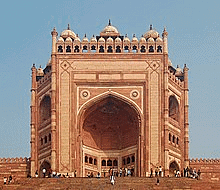Humanities/Arts Exam > Humanities/Arts Notes > Fine Art for Class 11 > Important Points: Some Aspects of Indo- Islamic Architecture
Important Points: Some Aspects of Indo- Islamic Architecture | Fine Art for Class 11 - Humanities/Arts PDF Download
1. Spread of Islam in India:
- Islam spread towards Spain and India in the 7th and 8th centuries CE.
- Brought to India by Muslim merchants, traders, holy men, and conquerors.
- Large-scale building activity began under the Delhi Sultanate in the early 13th century.
2. Architectural Techniques:
- Introduction of archuate form of construction with arches and domes.
- Use of voussoirs (interlocking blocks) and keystones for arches.
- Domes rested on pendatives and squinches.
3. Indo-Saracenic/Indo-Islamic Architecture:
- Blend of local cultures and traditions with Islamic architectural practices.
- Development of arabesque, geometrical patterns, and calligraphy on plaster and stone.

4. Types of Structures:
- Mosques, Jama Masjids, tombs, dargahs, minars, hammams, gardens, madrasas, sarais, kos minars.
5. Styles of Indo-Islamic Architecture:
- Imperial Style (Delhi Sultanate).
- Provincial Style (Mandu, Gujarat, Bengal, Jaunpur).
- Mughal Style (Delhi, Agra, Lahore).
- Deccani Style (Bijapur, Golconda).
6. Materials and Decorative Forms:
- Use of rubble masonry, dressed stone, limestone plaster.
- Polychrome tiles for walls.
- Stone carvings, stucco, painted motifs, arabesques, calligraphy.
- Use of blue, turquoise, green, and yellow tiles.
7. Significant Monuments:
- Qutub Minar: 234-feet-high, built of red and buff sandstone, highly decorated balconies.
- Chand Minar (Daulatabad): 210-feet-high, four storeys, chevron patterning.
- Humayun’s Tomb, Taj Mahal: Paradisiacal imagery, charbagh style.
- Tombs of Ghyasuddin Tughlaq, Akbar, Itmad-ud-daula.
8. Forts:
- Examples: Chittor, Gwalior, Daulatabad, Golconda.
- Strategic designs for defense, concentric walls, staggered entrances, labyrinthine pathways.
9. Sarai:
- Public accommodations for travelers, merchants, and pilgrims.
- Sites for cross-cultural interaction.
10. Provincial Style Example - Mandu:
- Mix of official and residential buildings.
- Examples: Royal Enclave, Jahaz Mahal, Rani Rupmati’s pavilion.
- Use of local stone and marble.
11. Taj Mahal:
- Built by Shah Jahan as a mausoleum for Mumtaz Mahal.
- Known for symmetry, marble, Chahar Bagh layout, and pietra dura work.
12. Gol Gumbad:
- Mausoleum of Muhammad Adil Shah in Bijapur.
- Known for massive dome, acoustical system, and whispering gallery.
The document Important Points: Some Aspects of Indo- Islamic Architecture | Fine Art for Class 11 - Humanities/Arts is a part of the Humanities/Arts Course Fine Art for Class 11.
All you need of Humanities/Arts at this link: Humanities/Arts
|
10 videos|24 docs|16 tests
|
Related Searches
















